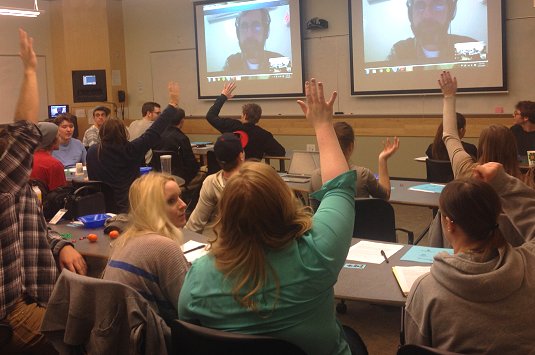
How to ‘be Boulder’ with climate communications. A webcam session of Paying for predictions

The Climate Centre last Thursday remotely facilitated a session at the University of Colorado-Boulder of Paying for predictions – its popular game illustrating the cost, value and use of early warnings in which players decide whether to invest in forecast-based preparedness for floods.
Nearly 40 students took part in the game, part of the university’s “Inside the Greenhouse” course on how to communicate climate issues through interactive arts and media.
The session was led (see photo) from Boston, Massachusetts by the Climate Centre’s Associate Director for Research and Innovation, Dr Pablo Suarez, on a simple webcam link via Skype.
It was co-facilitated in Boulder by Professor Max Boykoff of the CIRES Center for Science and Technology Policy, Beth Osnes of the Department of Theater and Dance, and Scott Gwozdz from the Business School.
Engagement
“It’s not the first time we’ve done this,” said Professor Boykoff, “and link-up technologies now provide great opportunities to connect from afar.
“Pablo was interacting very well with the students on webcam.”
Paying for predictions, in which participants play humanitarian workers processing probabilistic information about disasters, was among the selection of educational games run by the Climate Centre at the UN climate talks in Warsaw, Poland last November.
Last week’s session is one of numerous engagements between the Climate Centre and the University of Colorado-Boulder (home-page strapline: Be Boulder).
In another, the University of Colorado is one of a number of campuses that helps the Climate Centre place interns from a graduate student pool in countries like Kenya, Uganda and Zambia. (More information is here)
Researchers from the two organizations are also working on an assessment of the effectiveness in the field of participatory games.
Professor Beth Osnes, Director of Graduate Studies in CU Boulder’s Department of Theatre and Dance, writes: “Inside the Greenhouse: Using Media to Communicate Positive Solutions to Climate Change” leads students into creating multi-modal compositions on issues related to climate change.
Storylines
They are encouraged to explore multiple outlets for creative expression, from video to dance, generating compelling storylines as they go.
“El Verde”, a self-proclaimed environmental voice, for example, raps about how you too can make a difference.
A family that includes an environmentalist and a hunter find they share a reverence for the environment.
A character ironically named Steve Coalburner seeks to impress his attractive co-worker, Stacy Green, by car pooling.
These are just a few of the stories created by students as part of the course, and games are another inspirational format for communicating climate-related content in a fun and engaging way.
Last week’s Paying for predictions session at the University of Colorado-Boulder was led remotely through a webcam link. (Photo: Scott Gwozdz/CU Boulder)